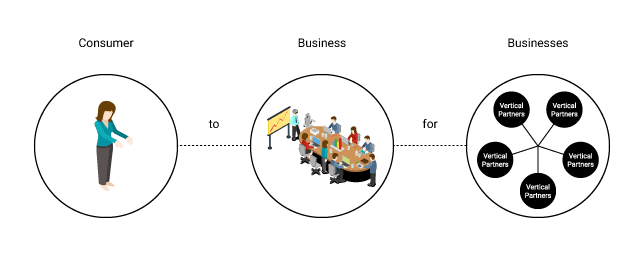C2B4B is the New B2B2C
6 min read
We are living in a time period of accelerated change. With the meteoric rise of startup unicorns and the downfall of corporate empires, the unprecedented change cannot be ignored. Due to the increased access to market and technology, the barriers to entry has been diminished. It is now both easier and harder to be the market leader as the game of market domination has evolved where the winners are the companies that are able to provide a wide variety of values to customers to cater for their ever-changing needs. This is especially true for businesses that operate in the model of B2B2C, which is no longer a viable strategy in the 21st century.
What is happening now?
The value chain from production to consumer is shortening due to the disintermediation of middlemen through the rapid adoption of platforms, emerging technologies, and open sourcze approaches derived from the shared economy. It is now easier, faster, and cheaper to go direct-to-consumer through shared platforms.
The value chain is also changing from linear to circular. Planned obsolescence is not a viable and sustainable approach anymore. Driven by warnings from global warming, educated consumers are becoming more conscious in their consumption. Hence they are likely to stick with companies that are able to close their loop from waste to renew.
Direct competitors are no longer the same companies operating in the same vertical markets within a geographical vicinity. The new competitors are companies that diversify their value proposition in market verticals beyond their core verticals and are able to create an ecosystem of interconnected experiences that works globally.
Consumers are becoming more savvy and demanding. With fluid expectations and little brand loyalty, the new generation of consumers compare, critique and switch to other brands if their ever-changing demands are not being met. Companies can only stay ahead of the game by continuously anticipating the provision of services that consumers do not know they need from the companies.
Companies are transitioning from offering products or services to offering experiences. This means product companies are starting to offer services. Service companies are starting to offer products. The combination of product service with business process innovation enables companies to provide compelling experiences that create business and social impacts.
Globalization’s ethos of one-size-fits-all is no longer a relevant go-to-market strategy to enter foreign markets, especially in emerging countries. Instead, companies need to glocalize by projecting a global vision and brand powered by local strategy and execution. Local content is the driver of market adoption.
With these market trends in mind, the 21st century is the time period where the experience economy will take place in full effect. Living in the experience economy means that the traditional B2B2C supply chain where businesses drive its way to the market with consumers is now irrelevant.
It now starts with consumers driving businesses instead to provide fluid services to fulfill the liquid expectations of consumers. And the only way to provide values to consumers anytime, anywhere in the relevant context requires businesses to leverage the shared and circular economy approaches by collaborating with other players to integrate their services to create a holistic and modular value proposition. Hence the necessity for companies that operate with B2B2C to shift its business model towards C2B4B.

C2B4B model always starts with the consumers first that drive every decision made, instead of B2B2B where business drives the decision.
C2B: Understand everything about the consumers drives every businesses decision on where to play and how to win.
B4B: Collaboration with various market players in different countries in order to create interconnected experiences.
C2B4B: Liquid consumer expectations drive businesses to deliver experiences that are interconnected, modular, and holistic, enabled by collaborations with partners using shared and circular economy approaches.
The C2B4B model means that the top-down approach will be flipped into a bottom-up approach.
Research, development, and marketing efforts are driven by consumers powered by real-time data analytics and pro-active anticipation of needs instead of reactive. Operations are completely aligned with the behaviors, buying processes, and mindset of the consumers instead of adjusting the timeline the company processes and procedures. Basically, everything driven by top-down management will flip to bottom-up driven by the liquid expectations of consumers.